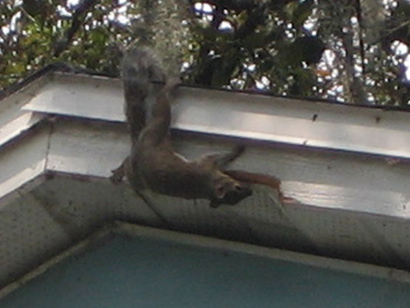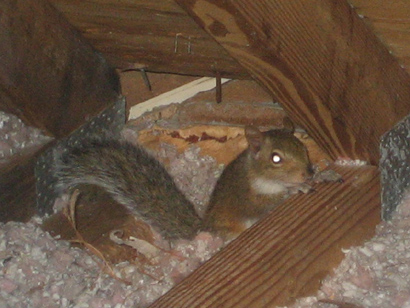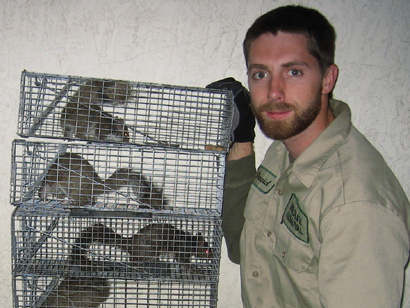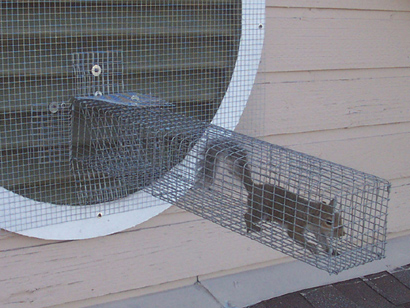- Squirrel Removal - Information about the humane trapping and removal of squirrels.
Squirrel Removal
Squirrels are very common in both the wild and in urban settings. They love to live in attics of houses! They find an opening near the roof or chew their way inside, and set up a nest. You may hear them scampering and scratching in morning and evening. They are easier to trap than most nuisance wildlife, if you use the proper techniques of mounting traps directly on entry and exit holes.
COMMON PROBLEMS: Squirrels can live anywhere with trees, and thrive in suburban environments. As rodents, they are great at gnawing and chewing. They give birth to young twice a year, and will use any warm, dry space they can find. They are obviously extremely agile, and can climb pretty much anything, and go anwhere they please. Thus, they cause some of the following problems:
- Chewing into an attic, and setting up a nest
- Fire risk from chewed electrical wires in attic
- Crawling into a chimney and living there
- Eating garden plants, bird seed, etc.
- Chewing on the wood of a house, porch, shed, etc.
- Dying inside walls or chimney, and causing odor problems.
- Concern about a sick or agressive squirrel on property.
SQUIRRELS IN THE ATTIC: This can be a complex case. This almost always involves an adult female and baby squirrels. Here are general steps for removing squirrels from an attic.
- Step 1: Inspect the home, and find the entry hole(s), which are often chewed open and obvious. Seal shut all secondary entry holes, but leave the primary one open.
- Step 2: Enter the attic. This is crucial. You might not see the squirrels, but you'll see evidence. You might find and remove the litter of baby squirrels by hand, or observe them to be large enough to run.
- Step 3: If the house is in good repair, mount a one-way excluder door on the primary entry/exit hole.
- Step 4: If chewing back inside is a concern, mount a repeater trap that catches all the squirrels as they exit.
- Step 5: Repair the primary hole with pro-grade repairs, and fix other damage in the attic.
- Step 6: Clean the attic, removing all feces, and spray with enzyme cleaner.
GENERAL SQUIRREL TRAPPING: Squirrel trapping is subject to state laws regarding capture and relocation or euthanization of wildlife. If you have unwanted squirrels outside the home, in some cases, the only fix is to trap and remove the nuisance wildlife. We can safely, legally, and effectively catch and remove your nuisance squirrels. Trapping is an art, and most amateur attempts go awry for a variety of reasons. An intimate knowledge of squirrel behavior, both prior to and after trapping, and of various squirrel trap types is necessary to ensure that the squirrel is trapped and removed without incident.
- STEP 1: Determine if trapping is necessary, or if there is a preventative alternative.
- STEP 2: Select the right trap for the situation, of at least a dozen types of squirrel traps.
- STEP 3: Set the traps in the correct areas, in shade, camouflaged, mounted in trees, etc.
- STEP 4: Use correct bait, but to be honest, trap setup & location are more important.
- STEP 5: Monitor the trap daily, remove trapped squirrels and transport them.
ATTIC DECONTAMINATION & OTHER SERVICES: In some situations, it may be desirable to clean your attic after you've removed squirrels from the space. They can leave behind large amounts of droppings, urine, hair, oils, food, nesting material, and so on. These remnants can attract insects like cockroaches, and the scent left behind can encourage new squirrels to attempt to chew or break their way into your house. You might also experience odor problems from the waste. It's possible or likely that mold will grow on the areas of feces and urine, and urine can damage wood or sheetrock. Some of the mold can potentially cause diseases that people can catch, and some of the feces themselves can cause diseases, such as Salmonella or Leptospirosis. It's also adviseable to repair any torn ductwork in an attic, along with any torn pipe insulation or chewed electrical wires.
- We remove or vacuum all droppings, or remove all the soiled insulation.
- We fog the attic with a special enzyme-based cleaner that destroys any organic matter and deodorizes the space.
- We repair damage, such as ductwork, electrical wires, pipes, insulation, and more.
How To Get Rid of Squirrel - Tips and steps for getting rid of squirrels.
How To Trap a Squirrel - Methods for catching squirrel in cage traps.
Squirrel in the Attic - Info about what to do if you have squirrel in the attic.
How to Kill a Squirrel - Does poison work to kill squirrel? Is killing squirrel the best approach?
Squirrel Feces - Pictures of squirrel poop and info about danger, and diseases from squirrel droppings.
Squirrel Prevention - Preventative methods for how to keep squirrel away from your property.
Squirrel Repellent - Analysis of various squirrel deterrents and repellent products.
What Bait Catches Squirrel - What kind of food do you put in a trap to catch a squirrel?
Squirrel on the Roof - If you hear scratching on the roof, and think it's a squirrel.
Squirrel in Your House - Tips on how to get a squirrel out of hour house.
Squirrel in the Chimney - Information about removing squirrel in a chimney.
Squirrel in the Walls - What to do if you hear squirrel in the walls, scratching.
Read more educational articles to learn All About Squirrels to help you with your squirrel problem. Learn from my experience if Mothballs or Ammonia help repel squirrels, and the kind of damage squirrels can do in an attic. Find out if Repellents are effective, and what attracts squirrels in the first place. I can show you how to Keep Squirrels Away from your Property and how to know if there are baby squirrels in the attic?. Find out if a squirrel in the attic will have a Nest of Babies and ways to keep squirrels out of your bird feeder. Learn what to do with a squirrel after you catch it? and if squirrels chew on wood. I can let you know if repellents will get squirrels out of a Chimney and even some humane ways to kill a squirrel in a cage. Let me show you How to Keep Squirrels out of your House and how to know if you have a Squirrel In Your Attic.
I can let you know if the city or county animal services will help you with a squirrel issue, and if your homeowners insurance will pay for squirrel damage. Learn how well squirrels can climb and jump and if it is safe to handle a squirrel with bare hands. I can show you how to keep squirrels out of your garden and how to use a one-way funnel to get squirrels out of a building. Learn about the squirrel's natural diet and what you should feed a found baby squirrel. Find out what to do if you find a nest of baby squirrels in your attic, and what diseases squirrels carry. I can let you know if a squirrel's feces are dangerous to touch or breathe and how to find and remove a dead squirrel in a house. Learn how to clean squirrel feces out of your attic and ways to kill a squirrel in the yard.
Find out if squirrels chew on electrical wires and what wildlife rehabilitators do with squirrels. I can show you how to get Squirrels out of a Wall and what to do about a squirrel under the porch. Learn if more squirrels live in urban or wild areas and what Equipment is needed to trap a squirrel. Read all about Lights and Sounds and Squirrels and learn how big squirrels can grow to be. Read about the symptoms of a sick squirrel and what to do about a cage-shy squirrel. I can show you how to take care of a squirrel on the roof and where you should relocate a trapped squirrel. I can answer the question: Do all squirrels have rabies?. Learn, too, if you should hire a pro, or remove squirrels yourself. I can show you how to catch a squirrel with a snare pole and how to get Squirrels Out Of The Attic. Read my thoughts on if you should ever poison a squirrel and even if squirrels make good pets. Read about what to do if you find an orphaned baby squirrel and if squirrels are ever active at night. Find out all about Squirrel nests, squirrel mating habits, what to do about a squirrel in your Living Quarters and if it is legal to trap a squirrel.
Eastern Gray Squirrel Information
Biology
Squirrels are the most commonly seen mammals in the world. The Eastern gray squirrel is a type of tree squirrel, commonly found in forests. They are also found in gardens, yards and parks; pretty much anywhere that has trees and shrubs in abundance. Eastern gray squirrels are of the genus Sciurus and from the family Rodent. The word ‘Sciurus’ is formed from two Greek words ‘skia’ and ‘oura’, meaning shadow and tail respectively. This definition translates to mean that Eastern gray squirrels like to sit in the shadow of their tails. The scientific name of eastern gray squirrel is Sciurus carolinesis.
Eastern gray squirrels, as the name indicates, are usually gray in color; however, their fur sometimes varies in colors and can become darker in different regions depending upon where they live. It is assumed that the color is based on the weather and climate of their habitats. Darker furred squirrels are mostly found in colder climates to help them adapt and survive in harsher environments. Their bellies are white and they have long, bushy tails that help them for balance as well as warding off predators. These squirrels are very agile and rotate their hind feet to help them climb head first down trees.
Habitat
Eastern gray squirrels are found mostly in the forests of North America and Canada. Because of their love of nuts, they enjoy the plentiful oak forests of North America. Squirrels live in nests constructed with leaves and other materials they gather. They also make use of nests built by other birds. They like the dense leaves of branches on trees such as Oak, Red Maple and Hickory as they provide food and protection from the elements and predators. Nuts of pretty much any variety are their main staple; however, they also eat apples, cherries, grapes blossoms and other vegetation. Squirrels are hoarders and spend a lot of their time gathering nuts and other food sources to stash away. Although they do not hibernate, the still collect stores of food to get them through the rougher parts of the seasons when food sources are not so readily available. They usually have several caches where they store food instead of just around their nests. This way they have several areas to retrieve their food in case any of their caches are found by predators or other animals.
Life Cycle
Squirrels normally mate in two seasons: from December to February and from May to June. During their courtship, they frolic in the trees trying to impress and attract potential mates. After mating, the male and female work together to build their nest for their young. The gestations for a mother squirrel is about 44 days and anywhere from two to eight babies are born in a litter. The babies are born without fur and are pink in color. Though they can live up to 20 years, the Eastern gray squirrel usually lives around twelve years.
Diseases Carried by Eastern Gray Squirrels
Easter gray squirrels are known to carry rabies and tularemia. Tularemia, also known as rabbit fever, is a very infectious bacterial disease. They also carry squirrel pox, which causes tumors to form on their bodies; however, this disease is not transmitted to humans but can be spread to other mammals such as rabbits.
Eastern Gray Squirrel Nuisance
Squirrels forage for food and at times may enter your home to gather any food supplies left out, such as garbage and left over foods. Attics and other areas of the home are great places for squirrels to take up residence and build their nests. As they breed and raise their young, they may become destructive; eating clothes, wires, garbage and other items. They can be loud creatures as well; their chirping and screeching as they communicate with each other can become very annoying to human inhabitants. As with any living creature, Eastern gray squirrels will leave urine and droppings around your home which pose a health hazard as well as producing foul odors to permeate the environment.





